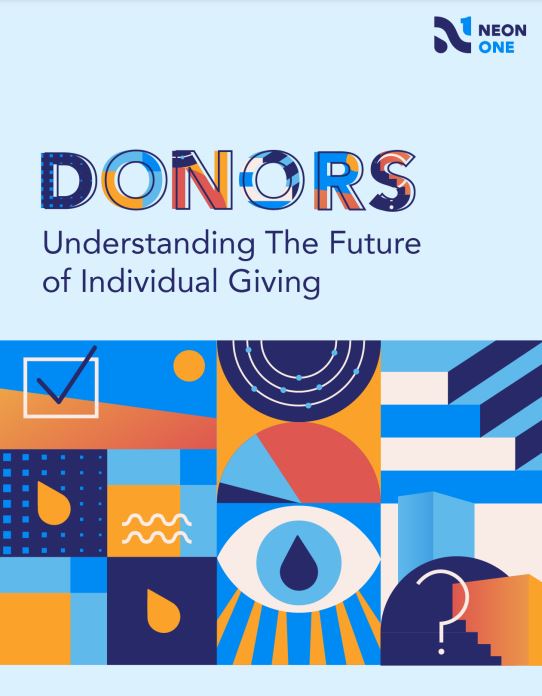NeonOne set out to understand what individual giving looks like in the post-pandemic world. By reviewing many sources including academic journals, industry reports, blogs, and more, they have synthesized six questions:
- Who are our donors?
- What do our donors support?
- When do our donors give?
- Where are our donors?
- Why do our donors give?
- How do our donors give?
In Neon One’s Donors: Understanding The Future of Individual Giving – Part 1, we focused on the first three questions. In this Part 2, we are focusing on the last three questions.
What are key findings from the article?
- Grants from donor advised funds in community foundations tended to stay in the community, according to the Lilly School of Philanthropy study. The researchers theorized that “the stronger local ties were, the more likely the donor was going to give to nonprofits in their community. They found that the longer an individual stays in the community that they live in, the more likely they are going to give to arts and human services organizations where they live.”
- The top three states for private boat ownership are: Florida, California, and Massachusetts according to a Windfall study. The top three states for private plane ownership are California, Florida, and Texas. The top states for luxury car ownership are California, Texas, and Florida.
- Donors prefer email for hearing about updates and appeals (48%) followed by direct mail as the preferred channel at 21% according to Data Axle.
- There are three primary motives for why donors give, according to Professor Jen Shang, Institute for Sustainable Philanthropy in the UK. They are situation-based, relationship-based, and identity based. The report summed up the difference between the three motives: Situation-based motivations are often triggered by sudden changes in the environment, and individuals respond by giving. Relationship-based motivations are when donors give based on their connection to an organization. Finally, identity-based motivations focus on giving as a way for the donor to express who they are.”
- Donor acquisition went up in 2020. “The percentage of donors acquired in 2020 who gave again in 2021 was at an all-time high in the first quarter and remained strong through the first half of the year.” But its unclear how many nonprofits closed their doors or stopped fundraising.
- The study found that while only 10% of US households have wealth in cash, 80% of donations are cash. “Nonprofits that receive stock donations see 55% higher fundraising growth than those that only accept cash.” You can check Schedule M of your organization’s IRS Form 990 to see if you received reportable asset gifts.
- Double the Donation estimated that $2-$3 billion was donated through matching gift programs. But estimates suggest that $4-7 billion may be going unclaimed since many donors may not know their gifts are eligible to be matched by their employers. Even more striking is the finding that “84% of donors are more likely to donate if their gift is matched.”
- Corporations are now offering donor advised funds (DAFs) as an employee benefit. Similar to United Fundgiving campaigns of the past, employees can designate small amounts from payroll to go into these DAFs.Firms outside of Fidelity and Charles Schwab are working with companies to provide these services.
- Dr. Russell James’ research found that while only 5% leave a gift to a nonprofit in their will, 33% would consider it if they were asked. Like Matching Gifts, that’s a lot of money left on the table.
- Recent research found that recurring gifts are more likely to start in January than December. That should impact messaging for nonprofits about the importance of these gifts. Plus, previous research has shown that recurring givers “have a retention rate of 90% and that recurring givers are six times more likely to leaven an organization in their will or make a legacy gift to an organization.”
What can I do as a result?
- “Think like a donor,” explained philanthropist Lisa Greer in her special aside in the report. What would a prospective donor want to see? Move away from transactional relationship with donors. Don’t over solicit! Remember that they are getting a lot of emails from nonprofits and companies every day. Engage with them like they are people. Because they are!
- Consider how your messaging reflects the different motives for giving. Are you appealing to the donor’s sense of identity or situation-based identity? Are you giving donors the ability to give to satisfy their image of themselves?
- Examine how your organization is talking about giving from assets, such as stock and property. As we’ve noted before, the largest gifts come from assets, rather than income.
- Explore how your organization is educating donors about matching gift potential. That is a really easy way to get in more dollars without too much effort.
- Review how your organization talks about recurring giving. Are you asking? When are you asking?
- Finally, remember that people want to give; they sometimes just need to be asked! Authentic communications with your donors will build the strongest relationships. Asking can be a natural part of an ongoing conversation your organization has with the donor, instead of rote solicitations sent according to a schedule disconnected from the donor relationship.
Additional Resources
- Donors: Understanding The Future of Individual Giving l NeonOne 2022
- Neon One’s Donors: Understanding The Future of Individual Giving – Part 1 l Aspire Research Group 2022
- Dr. Russell James reveals the secret behind major gift growth – psychology! l Jennifer Filla blog 2022
